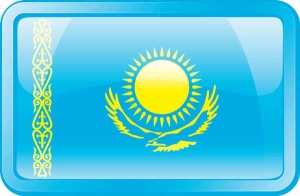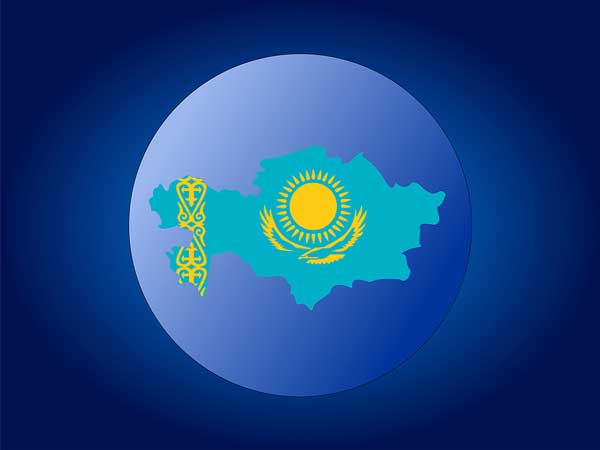By Dr. Richard Weitz
02/26/12 – China and Kazakhstan have generally achieved a harmonious relationship in which the two countries can engage in mutually beneficial economic, energy, diplomatic, and security partnerships that produce a “win-win” outcome for both parties.
For centuries, Kazakhstan’s leaders perceived China as their main security threat, inducing them to ally with Russia as a great power balancer. During the Cold War, Kazakhstan served as a forward base for potential Soviet military operations against the People’s Republic of China (PRC). After the USSR’s collapse, the initial focus of Astana and Beijing, after establishing diplomatic relations in 1992, was to delineate their new 1,600km (1,000 miles) common border.

- Kazakhstan’s close ties with Russia have constrained Sino-Kazakhstani cooperation. (Credit Image: Bigstock)
The two national governments progressively resolved their frontier differences in their joint communiqué of November 23, 1999, their bilateral protocol on border demarcation on May 10, 2002, and their comprehensive border agreement of December 20, 2006. The two governments also signed a bilateral accord to govern the use and protection of their cross-border rivers on September 12, 2001. In 2002, the Kazakhstani and Chinese governments signed a “Good Neighbor Treaty of Friendship and Cooperation,” an “Agreement on Cooperation Against Terrorism, Separatism, and Extremism” and an “Agreement Between the Chinese Government and the Kazakhstani Government on Preventing Dangerous Military Activities.”
In May 2004, the two countries established a China-Kazakhstan Cooperation Committee, which has served as a major governmental mechanism for developing their bilateral relationship. The Kazakhstani and Chinese presidents typically meet several times a year in bilateral and multilateral gatherings; other senior government officials often meet more frequently.
At these, Chinese and Kazakhstani leaders have taken care to express their support for the other country’s security, internal stability, and territorial integrity. While PRC leaders fear secessionist movements and religious extremism among its national minorities, Kazakhstani leaders worry about imported religious extremism and militancy.
In line with Chinese preferences, Central Asian governments regularly profess solidarity with Beijing’s counterterrorist concerns, which center on the Uighur-based East Turkestan Islamic Movement.
For example, when Chinese President Hu Jintao visited Astana in June 2004, the two governments issued a joint declaration that stated: “The two sides are determined to continue to take effective measures and work together in cracking down on all forms of terrorism, including the terrorist force of the ‘Eastern Turkestan Islamic Movement’ in order to safeguard the peace and stability in the two countries and this part of the world.” In addition, the communiqué affirmed that, “The two sides maintain that the crackdown on the terrorist force of the ‘East Turkestan Islamic Movement’ is an important part of the international fight against terrorism.”
The Chinese government has employed primarily diplomatic initiatives and direct security assistance to bolster Central Asian governments against mutual terrorist threats. By 2004, Beijing had signed bilateral counter-terrorism agreements with all four of its Central Asian neighbors. They include provisions for joint law enforcement operations, bilateral police training, and enhanced intelligence sharing.
To bolster ties with these governments as well as enhance their counterterrorist capabilities, Beijing has supplied Central Asian governments with defense equipment, military training, and intelligence information regarding terrorist threats.
The National Security Committee of Kazakhstan and the Public Security Ministry of China regularly conduct joint anti-terrorist exercises in border regions. Kazakhstani and PRC law enforcement agencies also collaborate against trafficking in narcotics and weapons. China’s defense academies now enroll Kazakhstani military personnel in their classes.
One unique factor differentiating China’s relations with Kazakhstan from those with the other Central Asian countries is their large overlapping ethnic groups.
About 180,000 ethnic Uighurs reside in eastern Kazakhstan. In addition, as many as one million ethnic Kazakhs live in China, especially in Xinjiang. Many ethnic Kazakhs have moved to Kazakhstan during the past decade as the country’s independence and reconciliation with China has generated new opportunities for travel between the two countries.
A major Chinese concern in relations with Kazakhstan is securing Astana’s support for Beijing’s efforts to curb “separatism” among China’s Uighur population. Central Asians often sympathize with the Uighurs’ separatist aspirations, especially since ethnic Uighur activists may have been inspired by the Central Asians’ own successful drives for independence and share the same Muslim faith as do many Central Asians.
Nevertheless, Kazakhstan and other Central Asian governments, while allowing Uighurs to practice limited degrees of political activity, do not permit Uighurs to engage in unauthorized activities in China and have deported Uighurs accused of terrorism by the Chinese. At Beijing’s urging, Chinese pressure forced the dissolution of the independent associations of Uighurs that had existed in Kazakhstan as well as the closure of the Institute of Uighur Studies that had been based at the Institute of Oriental Studies in Almaty.
Joint Kazakhstani-Chinese declarations also normally include a clause affirming the mainland’s position regarding Taiwan — that Beijing is the only legitimate government of China and that Taiwan is an inseparable part of Chinese territory. The communiqué issued when Hu visited Astana in August 2007, for instance, states that, “On the Taiwan issue, the Kazakh government reiterated its steadfastness in upholding the one-China policy and throws its support behind China for all efforts it has made to realize national reunification, recognizing that the Taiwan issue is China’s internal affair.”
When Taiwan held a referendum on March 22, 2008 on Taiwan’s joining the United Nations as a separate country, the Kazakh Ministry of Foreign Affairs declared Astana’s opposition to Taiwan’s independence aspirations and any attempt to create “two Chinas.”
In 2008, when various international groups have called on foreign government leaders to boycott the Summer Olympics in Beijing, or at least the opening ceremonies, to signal disproval of China’s policies regarding Darfur, Tibet, or other issues, the Chinese government solicited the endorsement of friendly governments of Beijing’s plans for the Olympics. The governments of Central Asia, including Kazakhstan, obliged. After Kazakhstani Prime Minister Karim Masimov met with Chinese Premier Wen Jiabao in April 2008, they issued a communiqué declaring that, “Kazakhstan supports China’s efforts in the preparations of the Beijing Olympics and will enhance coordination with China on strengthening the Olympic security work to ensure the successful and smooth holding of the Beijing Olympics.”
Kazakhstan’s close ties with Russia have constrained Sino-Kazakhstani cooperation.
On the one hand, much Russia-China trade go through Kazakhstan. On the other hand, Russia has sought to prevent the newly implemented Russia-Kazakhstan-Belarus Customs Union from serving as a backdoor for the smuggling of cheap Chinese goods into Russia. Moscow has therefore pressed Kazakhstan to tighten controls at the Kazakhstani-Chinese border before Russia and Kazakhstan eliminated their joint border checkpoints. Some Kazakhstanis complain that they can no longer buy cheap Chinese imports but must now spend more to buy often inferior quality goods from Russia and Belarus. Vladimir Putin’s proposed Eurasian Union, which the Kazakhstani government has said they would join, could erect further economic and perhaps other barriers between China and Kazakhstan.
China’s soft power resources in Kazakhstan are also weaker than those of Russia. The continuing dominance of Russian culture, the Russian media, and the Russian language has also limited Chinese influence in Kazakhstan. Although some 3,000 Kazakhstani students are studying in Chinese universities and colleges, the number of Chinese speakers in Kazakhstan is miniscule compared to the many Kazakhs who are fluent in Russian. Chinese is not one of the languages supported by the Kazakhstani government’s trilateral (Kazakh-Russian-English) language competency program.
China’s recent advancement into Kazakhstan’s economy has brought benefits to Kazakhstan, but it has also raised questions over increasing Chinese influence and its implications. Kazakhstani residents located near China complain about the expanding water use by the growing Chinese population in border regions, which has been reducing fresh water river flows to Central Asian communities located further from the rivers’ sources. Many Kazakhstanis do not believe that they have greatly benefited from China’s economic activities in their region, citing PRC managers’ tendency to hire Chinese workers even when operating in foreign countries.
Although many Kazakhstanis welcome China’s increasing involvement in their economy, especially as a supplier of cheap consumer goods and a potential market for Kazakh products, they also fear Chinese long-term ambitions in their country. A widespread worry is that demographic imbalances—Kazakhstan has the lowest population density in Central Asia—could entice Chinese immigration that would eventually lead to China’s de facto annexations of Kazakh territory. A related anxiety is that PRC’s growing wealth will result in Chinese ownership of important sectors of Kazakhstan’s economy.
These concerns became most evident in 1999, when the media criticized the decision by the national legislature to ratify what many Kazakhstani residents deemed as excessively generous concessions to Beijing regarding where to demarcate the China-Kazakhstan border. Popular concerns about “peaceful Sinification” of Kazakhstan’s under-populated regions compelled Kazakhstani authorities to re-impose visa requirements on Chinese nationals seeking to enter Kazakhstan. Concerns also have arisen in Kazakhstan about the bilateral trade imbalance—with Kazakhstanis urging the Chinese to buy (and help develop) Kazakhstan’s non-resource sectors.
Yet, Kazakhstan’s leaders likely admire their Chinese counterparts’ ability to achieve both high rates of economic growth and preserve their authoritarian political system. They also see ties with China as a useful counterweight to Moscow’s still dominant presence in their region.
Furthermore, Kazakhstanis anticipate that enormous size and commercial prowess of the Chinese will invariably give them a prominent place in their national economies, so most of their policies aim to channel the Chinese presence rather than constrain it. As Nazarbayev observed about China in his March 2006 annual address to the Kazakh parliament and nation, “There is no alternative to mutually advantageous ties with that dynamically developing country.”
The relationship between China and Kazakhstan is clearly a “win-win” for both sides.
Mutual benefits derive from their cooperation in trade, transport, energy, and telecommunications. The Kazakhstani government is keen to maintain balanced relations between China, Russia, Europe, and the United States to avoid domination by any single actor.
PRC leaders have also been restrained about antagonizing Russia by appearing to threaten Moscow’s interests in Central Asia. In many cases, these coincide or at least do not conflict with China’s core regional interests. Yet, this harmony also results from Kazakhstan and the rest of Central Asia’s being of lower strategic priority to Beijing than does Moscow. The PRC’s expanding interest in securing Central Asian energy and economic opportunities could lead Beijing to reconsider its policy of regional deference.
Featured Image: Credit Bigstock



